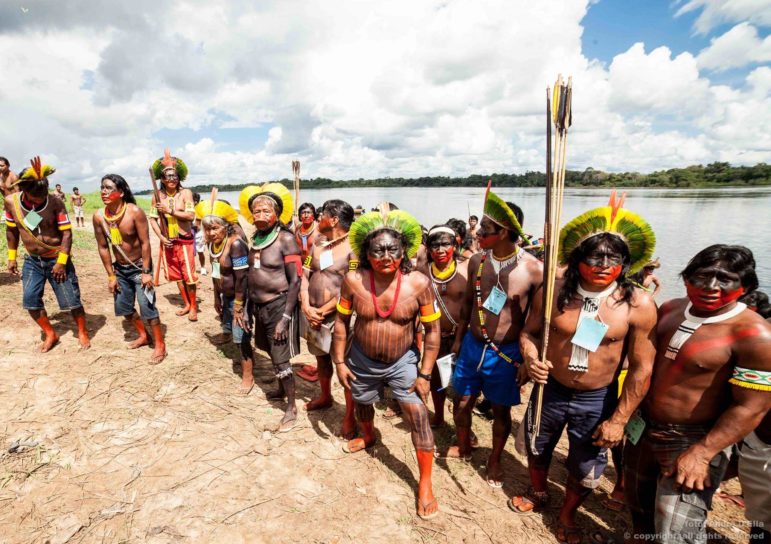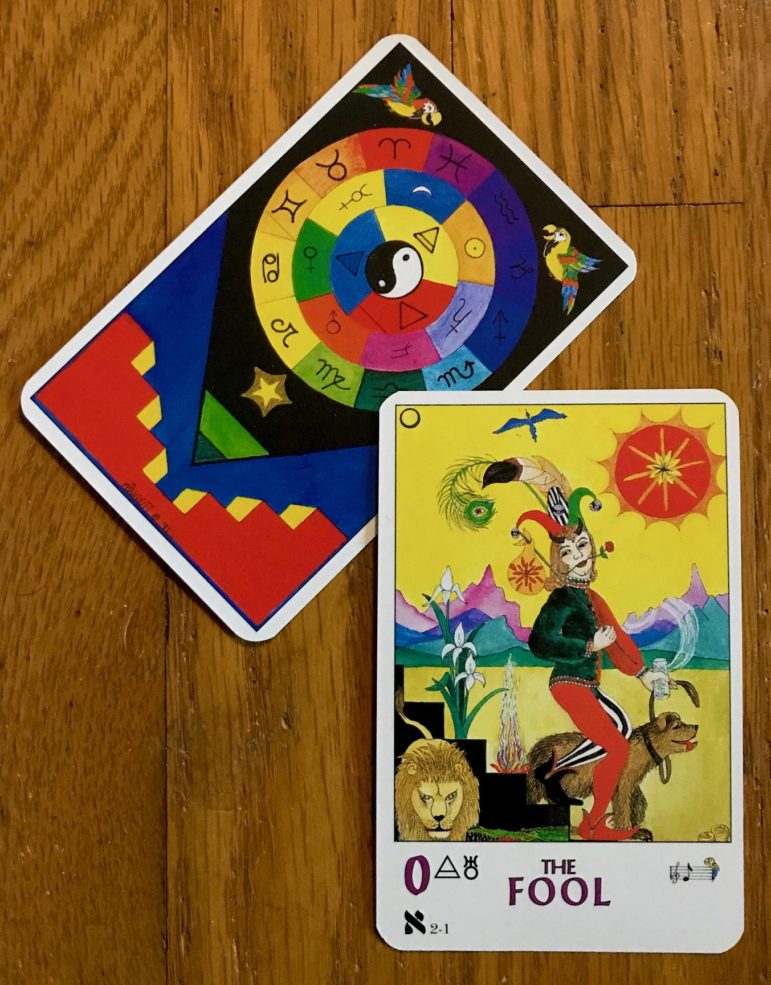
Kayapo Tribesmen – Image credit: Cheddartune – CC BY-SA 4.0
BRASILIA – As cases of COVID-19 in Brazil continue to skyrocket, Indigenous peoples are being impacted heavily impacted.
As of today, Worldometer reports Brazil as having 1,090,349 cases and 50,737 deaths from the disease. June 19 saw the highest number of cases to date in one day: 55,209 diagnosed cases and 1221 deaths.
The day before it was reported that Paulinho Paiakan, chief of the Kayapó people, had died from the disease in a hospital in Redenção. He was 66-years-old. He had been admitted to the intensive care unit on June 9 when he was intubated.
Paiakan gained international attention in the 1980s for leading the fight against the construction of Belo Monte, a hydroelectric plant that incorporated building one of the third largest dams on the Xingu River in the Brazilian Amazon rainforest. The plant was still built but was scaled back to about one-third of its original design largely due to the public outcry that Paiakan helped generate. It only began operation in 2016.
He also helped to broker a deal between tribal members and eco-friendly cosmetic retailer The Body Shop and its socially aware Trade Not Aid marketing initiative to collect Brazil nuts for use in The Body Shop’s products.
In 1992 Paiakan was accused of raping a student but was acquitted in 1994. Then he was convicted in a second trial in 1998 and sentenced to six years. Some of his allies claimed that the case was fabricated to undercut his growing political influence.
More recently, he had been back in the spotlight calling for the continued protection of the Amazon and speaking out against Brazilian President Jair Bolsonaro’s statements in favor of opening up the Amazon for mining and agriculture. The amount of deforestation in the Amazon is up by more than 50% for the first part of 2020.
The percentage of Indigenous people who have been infected with SARS-CoV-2 and died from COVID-19 is 12.6 nearly twice the national average of 6.4%. Over 5,500 Indigenous people have tested positive for the virus and close 300 have died from it.
Some researchers believe the number of cases and deaths are much higher than what is being reported. Gimena Sánchez-Garzoli, the Washington Office on Latin America (WOLA)’s director of the Andes, told CBS News on Wednesday that she wouldn’t “trust” numbers released by the Brazilian government.
“There are questions about really how much testing is going on in most of the areas worst affected, which may also influence the numbers,” Sánchez-Garzoli said. “The fact that it’s spreading like wildfire is completely not a surprise.”
* * *
 PHILADELPHIA – The Troth released the names of their new members of the Rede for the 2020-2021 term.
PHILADELPHIA – The Troth released the names of their new members of the Rede for the 2020-2021 term.
They also announced that Robert L. Schreiwer would be returning as Steer (President & CEO), and John Hijatt will resume his position as Associate Steer (Vice-President) and Clergy Liaison. The new members will join Thomas De Mayo, Carl Bonebright, and Philip Parkyn who are already serving on the Rede.
New Rede Member Bios:
- Lauren Crow is from Little Rock, Arkansas. She uses she/her pronouns. She previously served as the Public Relations Director for the Troth. She is a member of Black Bear Kindred of Central Arkansas. Lauren will be serving as the Troth Communications Director.
- SaeLokason is from Loveland, Colorado, and uses they/them or he/him pronouns. They have been a member of the Troth since 2016, have previously served as the Montana, Wyoming, and Colorado Steward and have recently been accepted as a clergy trainee. Sae will serve as Officer Liaison.
- Ethan Stark hails from New York City where he co-founded the North River Kindred. Additionally, he serves as an administrator of and public relations officer for Heathens Against Hate. A member of the Troth since 2014, he was most recently consecrated as a member of the Clergy (Godsman) for the organization. (Trothmoot 2020).
- Luke Babb lives in Chicago, Illinois, and uses they/them pronouns. They are involved with the Shope’s office and write a monthly column at The Wild Hunt.
* * *
On a less serious note, TWH contributor Azure West inspired by recent videos based on the “Pass The Brush” format but with a “Witchy” theme, created a “Pass The Tarot” version that incorporates a variety of participants and quite a few Wild Hunters.
In other news:
- On June 13, an unidentified woman’s body was recovered from the River Forth just west of South Queensferry, Scotland bearing what police described as tattoos and jewelry reflecting Pagan symbols. The authorities issued an appeal to the general public, along with pictures of her tattoos and jewelry in hopes of identifying her. She was identified several days later as 30-year-old, Veronica Frincu. The police said there were “no apparent suspicious circumstances” concerning her death, and also thanked members of the public for helping to identify her so family members could be notified of her death.
- A new novel written by Sandra Ireland, Sight Unseen, is helping to maintain the momentum of the campaign to pardon and apologize to the many women who were persecuted in Scotland for practicing “witchcraft.” While Ireland’s book is fiction, it draws heavily on historical records, particularly the cases of Lilias Adie, Janet Cornfoot, and Isobel Gowdie. Ireland said, “I wanted to give these women a voice, so I stitched together their stories to create the ‘every witch’ at the centre of my novel.” Queen’s Counsel, Claire Mitchell has been seeking both a pardon and apology for the people who were victims of the Witchcraft Act of 1563. Nearly 3,900 people were known victims of the act, with at least 2,600 being executed. Mitchell cites the actions taken in the U.S., “The witch trials of Salem are world-famous but involved only 200 people accused of witchcraft, 30 convicted and 19 hanged.” Mitchell continued, “Salem has reversed the convictions of all those who were executed, and the Massachusetts House of Representatives has passed a resolution honouring those who died. A memorial park was created in Salem with a bench for each person. But if you did that here, there just wouldn’t be enough room in a Scottish park.”
- The Royal Commission in Australia heard testimony last week that 29% of the Indigenous population in affected states were impacted by the bushfires of 2019-2020. Australian National University academic, Bhiamie Eckford-Williamson said, “… that 96,000 Aboriginal and Torres Strait Islander people, including 35,000 children, were affected by the fires that burned in Queensland, New South Wales, the Australian Capital Territory and South Australia this summer.” Eckford-Williamson also cited that 4.6 of Indigenous populations had been “disproportionately affected,” and that the response exhibited an “extraordinary absence of Aboriginal people” from post-fire inquiries and a lack of recommendations or policies specifically geared to acknowledging or reducing the impact on Aboriginal people. Three other experts gave evidence on the panel with Eckford-Williamson before the Royal Commission: associate professor Michael-Shawn Fletcher, a Wiradjuri man and paleo-ecologist from the University of Melbourne; University of Wollongong researcher Vanessa Cavanagh, a Bundjalung and Wonnarua woman and former firefighter researching the role of women in cultural burning; and Dr. Timothy Neale from Deakin University. The panel also addressed “cool-burning techniques” used by Aboriginal peoples and stated they could not be considered as “cultural burnings” by the fire management services unless they were done by Indigenous people who had control of the land. These techniques have been demonstrated to reduce the incidence of catastrophic fires in the areas where they are practiced.
- Earlier this month, German archaeologists revealed they had discovered an 8 cm tall (3.14 inches) Roman statue of the Egyptian deity Isis from excavations that took place two years ago in the city of Krefeld in western Germany. Hans-Peter Schlueter, Krefeld’s archaeologist said, “This is an unusual discovery from the Roman era in the Lower Rhine region.” The statue which is made of clay, depicts Isis sitting on a throne and holding a child. The statue was discovered in an old waste pit along with a jug of clay. Researchers believe the jug may have been part of a home altar. The site of excavation was part of the Roman border on the Rhine to protect against the Germanic tribes. The site has yielded over 90,000 items, and German archaeologists believe it could be eligible to be included on the UNESCO World Heritage List. The United Nations could issue a decision on the site as early as July of 2021.
- A new discovery near Stonehenge revealed a series of shafts aligned to form a circle that spans over 1.2 miles (2 km). “This is an unprecedented find of major significance within the UK. Key researchers on Stonehenge and its landscape have been taken aback by the scale of the structure and the fact that it hadn’t been discovered until now so close to Stonehenge,” said Professor Vincent Gaffney, a leading project archaeologist. The circle of deep shafts appears to be a structure that was designed as a boundary to help guide people to Durrington Walls, a sacred site, which sits at the center of the circle and approximately 1.9 miles (3 km) north-east of Stonehenge. Each shaft measures approximately 5 meters deep and 10 meters in diameter. Unfortunately, about 40% of the site cannot be studied or excavated sue to the encroachment of modern development. Gaffney also said, “The size of the shafts and circuit surrounding Durrington Walls is currently unique. It demonstrates the significance of Durrington Walls Henge, the complexity of the monumental structures within the Stonehenge landscape, and the capacity and desire of Neolithic communities to record their cosmological belief systems in ways, and at a scale, that we had never previously anticipated.” Radiocarbon dating of the shafts puts their construction in the same range as both Stonehenge and Durrington Walls, but the shaft’s layout also seems to include the Larkhill causewayed enclosure which predates Durrington Walls by about 1,500 years.
Tarot of the week by Star Bustamonte
 Deck: The Parrott Tarot Deck by Margaret Parrott (with the guidance of Thom Parrott), published by S.S. Adams Co.
Deck: The Parrott Tarot Deck by Margaret Parrott (with the guidance of Thom Parrott), published by S.S. Adams Co.
Card: Major arcana, (0) The Fool
The week ahead has the potential for new beginnings that are inspired and possess elements of idealism and spirituality but also call for balance. Jumping feet-first with eyes closed into the fray would be foolhardy, and produce less than desirable results.
Decks generously provided by Asheville Raven & Crone.
The Wild Hunt is not responsible for links to external content.
To join a conversation on this post:
Visit our The Wild Hunt subreddit! Point your favorite browser to https://www.reddit.com/r/The_Wild_Hunt_News/, then click “JOIN”. Make sure to click the bell, too, to be notified of new articles posted to our subreddit.
